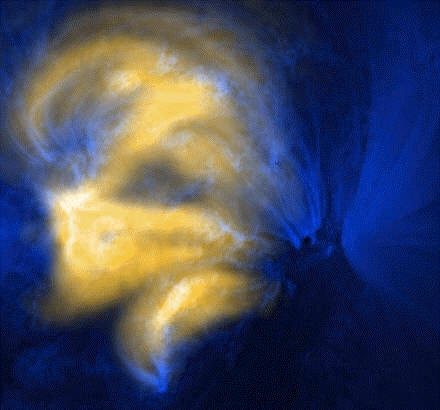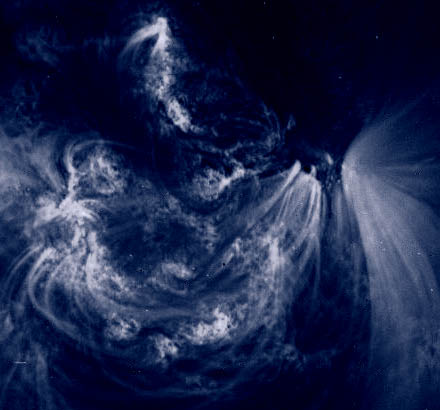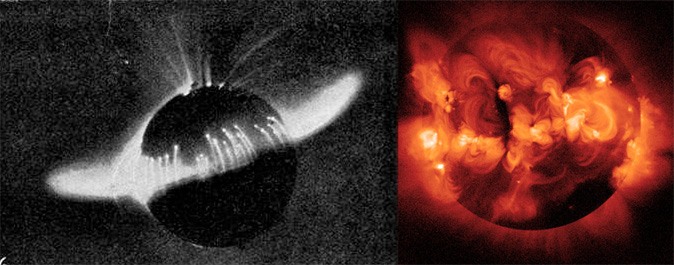Let's start here.
Reference:
http://www.catastrophism.com/texts/bruce/era.htm
To start with, I simply note that Bruce does not mention gamma rays at all. So I have no idea what he thought they should look like, or even if he thought about it at all.
I'm not sure they have been observed during his lifetime so for now I guess we'll have to assume that to be the case.
Now, right at the top of the page Bruce says (emphasis mine) ... "The object is to show that all cosmic atmospheric phenomena can be explained as deriving from electrical discharges, resulting from the breakdown of electric fields generated by the asymmetrical impacts between dust particles, such as are effective in terrestrial electrical sand and dust storms and in thunderstorms." What, exactly is the bolded phrase supposed to mean? Does it mean literally everything that happens in the atmosphere? or does it mean only electromagnetic things that happen in the atmosphere? Or perhaps "cosmic" is supposed to refer to connections between processes in the atmosphere and processes in space? I find Bruce's very first sentence rather cryptic.
I find it cryptic as well, and the term "cosmic" seems misplaced, at least at first glance. I guess the only thing I can say is that he realized there were cosmic rays that could in fact impact with the atmosphere. It could mean he expects to observe very large inbound as well as outbound 'rays' like the outbound rays that Birkeland created with his sphere. Presumably these rays could connect with other physical bodies in space.
But clearly he thinks that the same dust mechanism is at the root of the sun's electrical activity, because he says so: (emphasis mine again) ... "It is thus fortunate that we are able to see the details of the sun's atmospheric structure in sunspots, and verify that it conforms to the picture which the discharge theory had led us to expect; that is, a general background atmospheric temperature of around 4,000°K in which electric fields can be built up by asymmetrical impacts between solid particles, just as occurs in terrestrial sand and dust storms and in the ejectamenta above volcanoes."
In answer to your question, I know that Bruce is wrong because his proposed mechanism for generating electric charge is not physically possible.
Quite the contrary IMO, he hit the nail on the head as I see it. IMO those "active regions" are often triggered by volcanic activity. I don't think he actually believed that the sun had volcanoes or a crust, but IMO his words are prophetic none the less.
The maximum temperature that dust grains ("solid particles") can survive is about 2000 Kelvins, half of Bruce's optimistically low 4000 Kelvin background temperature. At photospheric temperatures solid particles would be smashed apart by the high speed collisions, or broken apart by the high ultraviolet photon flux. So I will say that Bruce's hypothesis is simply impossible.
I see signs that it is not only possible, but actually quite probable. Birkeland's arcs were typically congregated at the "bumps" of his sphere, and volcanic activity usually sets off electrical discharges in the Earth's atmosphere. CME's are often "point like" in their emissions of particles, including the one that set off the wave in Kosovichev's video.
Now let us go on.
I do acknowledge that it is one known and verified way to generate gamma rays. But there are other known and verified ways to generate gamma rays too, so why not acknowledge them as well?
Which ones naturally occur in the atmosphere? Cosmic rays and discharges are the two most likely culprits are they not?
It is not reasonable to simply assume that all or most of the gamma rays are generated by one and only one mechanism, that's the process of trying to force nature to bow to our pre-conceptions.
I would say it's more of a matter of watching how nature functions here and applying it there. There is nothing "new under the sun" about discharges in the atmosphere of spheres in space, and those million mile per hour charge particles flying off the sun are a form of "electrical current".
Rather, the reasonable thing to do is look at the gamma rays and let them tell you, by their physical characteristics (line width & line shape, band center & band width, spectral energy distribution, relative line strengths & etc.) how they were generated. Let nature lead the investigation, not prejudice.
Ok, but then we do know of two likely culprits, so there is no need to start making up options on the fly is there?
When we do that we find that the sun generates gamma rays from all manner of sources. There is of course the ubiquitous e-/e+ annihilation line at 511 keV, the neutron capture line at 2.223 MeV, nuclear de-excitation line emission from C, O, Ne, Mg, Si, and Fe, as well as bremsstrahlung from accelerated electrons. The bremsstrahlung is the component that you would assign to "electric discharge", since the narrow line emission obviously is not.
Woah. Wouldn't a powerful discharge through these elements create these specific emissions lines particularly in a z-pinch scenario? Again, I think we should look at the obvious candidate before *assuming* it's due to something exotic and foreign to our own atmosphere?
Electric discharge, as I understand the words, is not physically reasonable. In order to have "electric discharge", you have to mechanically separate charges to build up a strong electric field (that's what Bruce tries to do).
That's what the sun does too IMO.
Then you get breakdown and discharge arcs. Then you have to do it all over again.
Active cycles are full of volcanic events, and the discharge in Birkeland's experiments is *constant* and not only occurs at surface point to point discharges, but also as a discharge process between the sphere (crust) and the heliosphere (sides of his experiment).
It's pretty hard to tell the difference between that scenario and a perpetual motion machine. If the energy we see is all supposed to come from the discharges, then where does the energy come from, and what is the mechanism, that produces charge separation in the first place?
Well, according to Bruce it's a fission process in the core. It could be fusion too I suppose. The sun could have a core that spin significantly faster than the crust and generates induction currents. It could be a lot of things.
And since you are separating charges in an electrically conductive environment, how do you prevent quick discharge, and manage to build up strong electric fields?
You don't prevent it which is why we observe CME's that discharge toward the heliosphere in huge bursts.
It makes far better physical sense to realize that magnetic reconnection will transfer a great deal of kinetic energy directly to the plasma,
This makes absolutely no sense to me. We already know that a discharge will transfer a great deal of kinetic energy to plasma. Why do we need something "exotic" to explain something that is naturally occurring right in our own atmosphere?
and that Faraday's Law will also generate strong (but temporary) electric fields as a result of the ubiquitous and unavoidable dynamo magnetic fields in the photosphere.
That solar wind acceleration process isn't "temporary", it's constant and affects the entire surface.
This completely avoids all of the physical difficulties related to discharge mechanisms, is all completely consistent with known basic physics, and is all completely consistent with the wide variety of observed properties of the sun.
It's rather a funny to hear you say it avoids difficulties. It's difficult for me to imagine why you would select something that does not occur in our own atmosphere naturally over something that does occur naturally and fits all the necessary requirements.
Electrical discharges:
A) Heat plasma to millions of degrees
B) pinch free neutrons from plasma
C) cause plasma in the atmosphere of earth to emit gamma rays.
D) cause plasma in our atmosphere to emit x-ray and other high energy signatures.
E) can generate explosive double layers.
F) generates z-pinch spiraling filaments.
G) generates "Birkeland currents" inside plasma.
H) create "loops" in the atmosphere of a sphere in a vacuum.
I) accelerate particles from the sphere and generate "rays" from the sphere.
J) create jets from Birkeland's sphere.
Why do we need an exotic sort of energy exchange when nature has already provided a "simpler"" explanation that occur in our own atmosphere and we know for a fact it works in a lab?
In short, the mainstream models work well and make physical sense, whereas the electrical discharge mechanism does not work and does not make physical sense.
Not only do Birkeland's ideas "make sense", they actually work in a lab and produces many if not all of the same basic observations, including jets, full sphere particle accleration, high energy atmospheric discharges, etc. Birkeland left nothing to chance. It works and it makes sense.
Mainstream theory on the other hand begins with a foreign process that does not occur in our atmosphere naturally nor any other planet we've visited or studied. Mainstream theory makes no sense unless you describe MR as a 'current' running through the "magnetic line'. That's probably why Alfven called the whole idea of magnetic reconnection "pseudoscience". It "sort of" conveys the actual process, but it's easily misunderstood as being separate from a standard discharge process when it fact it is a discharge phenomenon.
Hence, unless you can come up with far stronger arguments than you have managed to muster thus far, I will stick to the mainstream.
Well Tim, all I can say is that the mainstream theory is *NOT* lab tested, it really doesn't explain why solar wind continues to accelerate as it leaves the surface and it doesn't explain a constant full sphere release of accelerating charged particles. It has all the math of course but the same was true of Chapman's theories and they turned out to be wrong mainly because he never "tested" them in the real world. I'll stick with what I *KNOW FOR A FACT* works in a lab.





